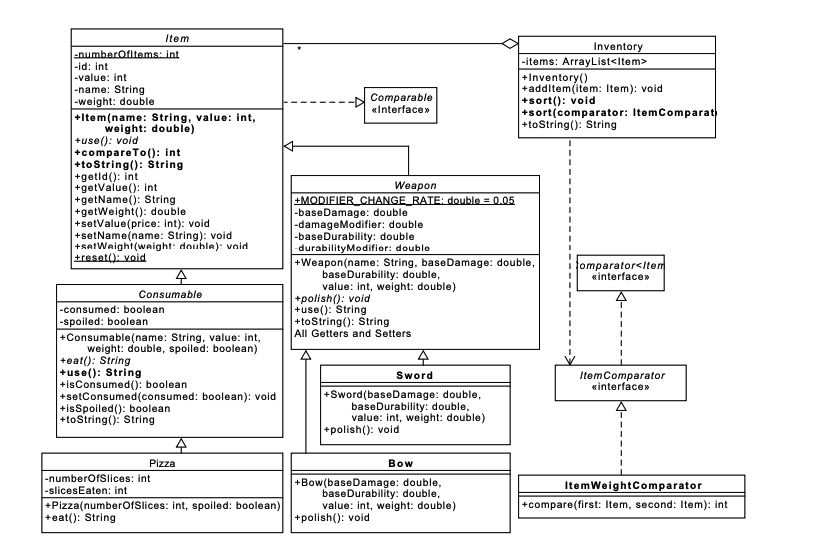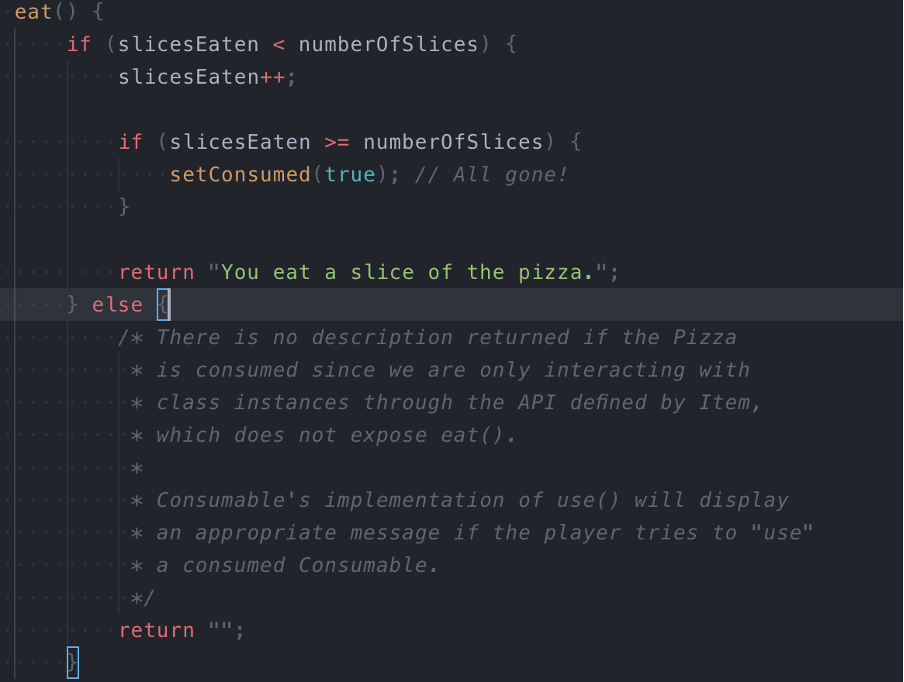6. 📚 Home Task
The home task should be done using TypeScript.
info
The starter code for the home task is located in docs/3-building-blocks-of-oop-part-2/hometask folder
Check the UML representation of a set of classes that represent the inventory and various types of items.
The classes and methods in italics are abstract. The concrete child classes must implement all methods from the abstract parent classes. Item, Consumable, and Weapon are the abstract classes.
The line from Item to Comparable indicates that Item must implement the Comparable interface. Similarly, the ItemWeightComparator class must implement the ItemComparator interface, which extends the Comparator interface. ItemWeightComparator compares items based on their weight.

Specific Steps
The Item class is the common ancestor to the various types of items that can exist in this fantasy game.
All instances of
Itemare given a unique number id. These are to be assigned by theItemconstructor. The first instance of an item is assigned an id of 0 (zero); the next is assigned 1, etc. Note that you have available a class variable that will help with the implementation of the constructor (and there is a staticreset()method).compareTo(other: Item): TheItemclass implements theComparableinterface. This requires adding thecompareTo(other: Item)method to the class. ThecompareTo(other: Item)method takes in another instance ofItemand compares it to the current instance. If the current instance's value field is greater than other's value field then the method should return a positive integer (convention is 1). If the current instance's value field is less than other's value field then the method should return a negative integer (convention is -1). If both items are equal, then compare the name field of the items lexicographically (meaning, compare each character in the strings based on its value, ignoring case. i.e.A == a), returning the appropriate value.Item.toString(): for anItemwith the name of "ring", a value of 3000, and a weight of 0.013, the method must return a string in the following format (excluding the quotes):"ring − Value: 3000, Weight: 0.01"
The ItemWeightComparator class implements the ItemComparator interface, meaning instances of it can be passed to methods requiring a comparator for objects of type Item.
- The
compare(first: Item, second: Item)method ofItemWeightComparatorshould function similarly to thecompareTo(other: Item)method of theItemclass, but for the weight field of theItems. If the weights are equal, this method should call thecompareTo(other: Item)method of the firstItemand return the resulting value.
The Weapon class is an abstract implementation of Item and describes items that can deal damage and break from use. All instances of Weapon have a base damage value baseDamage and a modifier to that value damageModifier. The sum of these two values determines the effective damage that this Weapon can do on a single use. In addition, Weapons have a base durability value baseDurability, and a modifier to that value durabilityModifier. The sum of these two values determines the effective durability of the Weapon. When this sum reaches zero or less, the effective durability is zero and the Weapon is considered to be broken and cannot be used.
You need to implement the next methods:
Weapon.getDamage(): Returns the effectiveWeapondamage.Weapon.getDurability(): Returns the effective durability of the Weapon.Weapon.toString(): for aWeaponwith the name of "hammer", a value of 300, a weight of 2.032, abaseDamagevalue of 30.4219, adamageModifierof 0.05, abaseDurabilityof 0.7893, and adurabilityModifierof 0.05, the method returns a string in the following format:"hammer − Value: 300, Weight: 2.03, Damage: 30.47, Durability: 83.93%"Weapon.use(): This method returns a string describing what happens when aWeaponis used. For aWeaponwith the name of "hammer", and an effective damage of 30.4725, the method should return the following:"You use the hammer, dealing 30.47 points of damage.""Using" a
Weaponlowers (subtracts) its effective durability byWeapon.MODIFIER_CHANGE_RATE. If the effective durability of theWeaponhits or drops below 0, theWeaponwill "break". If theWeapon"breaks", the method should output the previous string, but additionally with a newline character and the additional text "The hammer breaks.":"You use the hammer, dealing 34.05 points of damage. The hammer breaks."For a
Weaponwith the name of "hammer", if it is "broken" (The effective durability is 0 or less), calling itsuse()method returns the following:"You can't use the hammer, it is broken."
In this case, there is no change to durabilityModifier.
The Sword class is a concrete implementation of Weapon that you must provide.
- All instances of the
Swordclass have the name "sword". Sword.polish(): This method increases the instance's damageModifier by addingWeapon.MODIFIER_CHANGE_RATEeach timepolish()is called, up to 25% of thebaseDamagevalue. If the base damage of a sword were to be 100, then the maximum that the effective damage could be increased to would be 125.
The Bow class is a concrete implementation of Weapon that you must provide.
- All instances of the
Bowclass have the name "bow". Bow.polish(): This method increases the instance'sdurabilityModifierby addingWeapon.MODIFIER_CHANGE_RATE. Any changes are capped such that effective durability is no larger than one (1).
The Inventory class is a container for items in this fantasy game. You need to add the following methods:
Inventory.sort(): This sorts the items in theInventoryinstance based on their value.Inventory.sort(comparator: ItemComparator): This sorts the items in theInventoryinstance based on their weight.Inventory.toString(): returns string representation of the item list (.join(', ')).
The Consumable class describes those items that can be eaten by the player. Consumables can be marked as consumed, and can be spoiled. These properties are stored in the instance variables consumed and spoiled, respectively. A newly-created Consumable object should have its consumed field set to false.
Consumable.use(): If aConsumableis not spoiled and is not consumed, calling this simply returns the value from a call toConsumable.eat(). For aConsumablewith the name of "bread" that has already been consumed, this method returns the following:"There is nothing left of the bread to consume."
Assuming for this Consumable named "bread" that the value returned by a call to its eat() method is the following:
"You eat the bread."
If this "bread" were to be spoiled, the method returns this string, appended with a newline and the text "You feel sick.":
"You eat the bread.
You feel sick."
Specific instructions
- Start from creating
Item,Consumable, andInventoryclasses. - Create the
Sword,BowandItemWeightComparatorclasses
Implementation details
- both int/float types in the UML diagram represents "number" type in Typescript;
Itemclass:numberOfItemsis static getter property which returnscounter(keep it outside class declaration and increment every time class constructor is executed)reset()method should assign 0 to thecountercompareTo(other: Item)- see description above
Consumableclass:- consumed is
falsewhen create new instance
- consumed is
Inventoryclass:items-Item[]sort()method is polymorphic and has 2 declarations:sort()andsort(comparator: ItemComparator)
Weaponclass:- don't forget to use
superinconstructor(note that parent classes can require extra fields, such asname)
- don't forget to use
Pizzaclass:- example of
eat()method:
- example of
Evaluation criteria
- Only some classes were implemented.
- Some classes were not implemented.
- Some required methods are missing.
- All tasks are implemented to a full extend.